maintenance schedule Oldsmobile Cutlass Supreme 1995 Owner's Manuals
[x] Cancel search | Manufacturer: OLDSMOBILE, Model Year: 1995, Model line: Cutlass Supreme, Model: Oldsmobile Cutlass Supreme 1995Pages: 340, PDF Size: 16.68 MB
Page 3 of 340
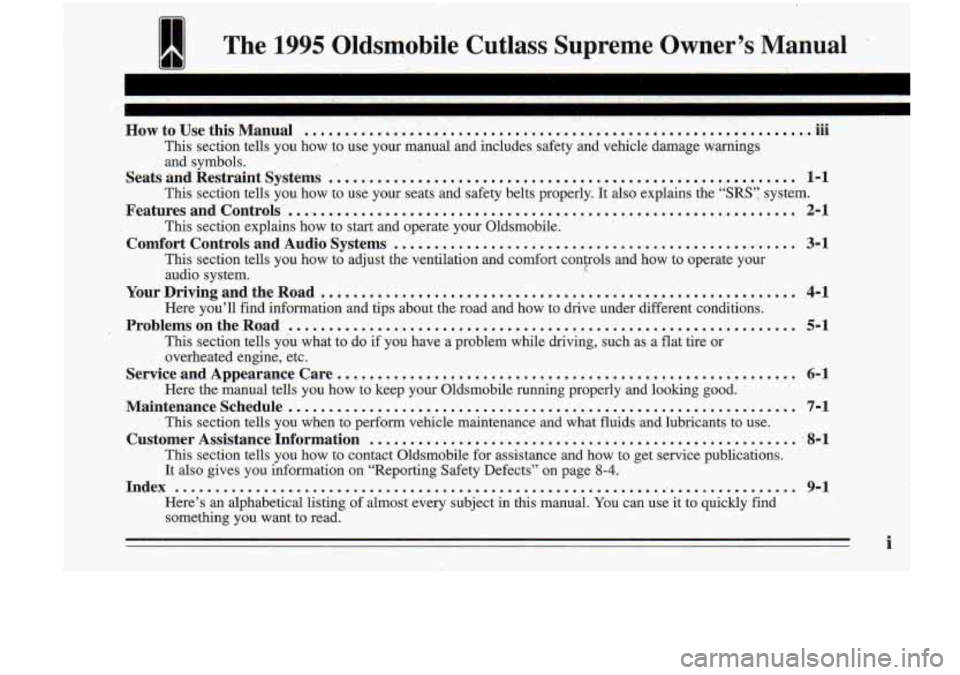
I The 1995 Oldsmobile Cutlass Supreme! Owner’s Manual
... How to Use this Manual ..................................... :.. ........................ .~II
This section tells you how to use your manual and includes sa\
fety and vehicle damage warnings and symbols.
This section tells you how to, use your seats and safety belt\
s properly. It also explains the “SRS’;.system.
Seats and Restraint Systems ........................................................... 1-1
Features and Controls ................................................................
This section explains how to start and operate .your Oldsmobile.
Comfort Controls and Audio Systems ..................................................
This’section tells you how to adjust the ‘ventilation and \
comfort conpols and how to operate your
audio system.
YourDrivingandtheRoad ...........................................................
Here you’ll find information and tips about the road and ho\
w to drive under different conditions.
ProblemsontheRoad ...............................................................
This section tells you what .to do if you have a problem while driving, such as a flat tire or
overheated engine, etc.
Here the manual tells you how to keep your Oldsmobile running \
properly and looking good.
This section tells you when to perform vehicle maintenance and what \
fluids and lubricants to use.
This section tells you how to contact Oldsmobile for assistance\
and how
to get service publications.
It also gives you infomation on “Reporting Safety Defects” on page
8-4.
Here’s an alphabetical listing of almost every subject in th\
is manual. You can use it to quickly find
something you want to read.
Service.and Appearance Care ..........................................................
Maintenanceschedule... ............................................................
Customer Assistance Information .....................................................
Index ........................................................................\
......
2-1
3- 1
4-1
5-1
6- 1
7-1
8-1
9-1
Page 172 of 340
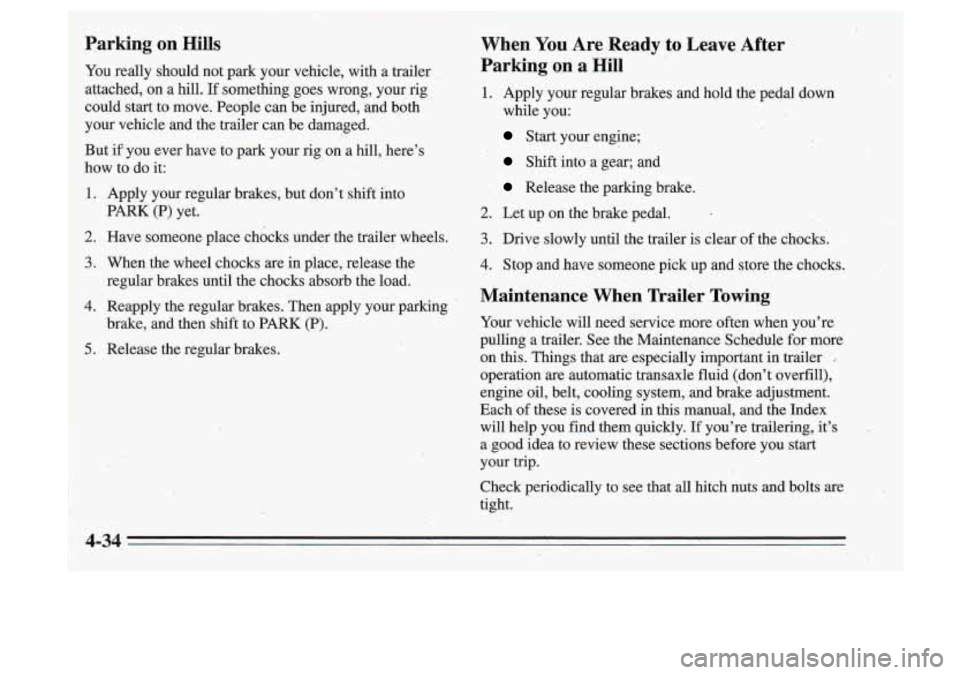
Parking on Hills
You really should not park your vehicle, with a trailer
attached,
on a hill. If something goes wrong, your rig
could start to move. People can be injured, and
both^
your vehicle and the trailer can be darnaged.
But if you ever have to park your rig on a hill, here’s
how to do it:
.I. Apply your regular brakes, but don’t shift into
.. !PARK (P) yet.
2. ‘Have someone place chocks under the trailer wheels.
3. When the wheel chocks are in place, release the
regular brakes until the chocks absorb the load.
4. Reapply the regular brakes. Then apply your parking
brake, and then shift to PARK
(P).
When You Are Ready to Leave After
Parking o,n a
Hill
1. Apply your regular brakes and hold the pedal down
8’. .
while you:
Start your engine;
Shift into a gear; and
Release the parking brake.
2. Let up on the brake pedal.
3. Drive slowly until the trailer is dear of the chocks.
4. Stop and have someone pick up and store the chocks.
Maintenance When Trailer Towing
Your vehicle will need service more often when you’re
pulling a trailer. See the Maintenance Schedule for,more
.on this. Things that are especially important in trailer
operation are automatic transaxle fluid (don’t oyerfill),
engine oil, belt, cooling system, .and brake adjustment.
Each of these
is covered in this manual, and the Index
will help you find them quickly. If you’re trailering, it’s
a good idea
to review these sections before you start
your trip.
Check periodically to see that all hitch nuts and bolts are
tight.
4-34,
Page 219 of 340

Air Cleaner
Pull out the filter. Be sure to install the air filter and
install the cover tightly when you are finished.
To check or replace the air filter, remove the four screws Refer to the Schedule to determine when to’
and pull off the cover.
replace the air filter.
See “Scheduled Maintenance Services” in the Index.
6-15
Page 220 of 340
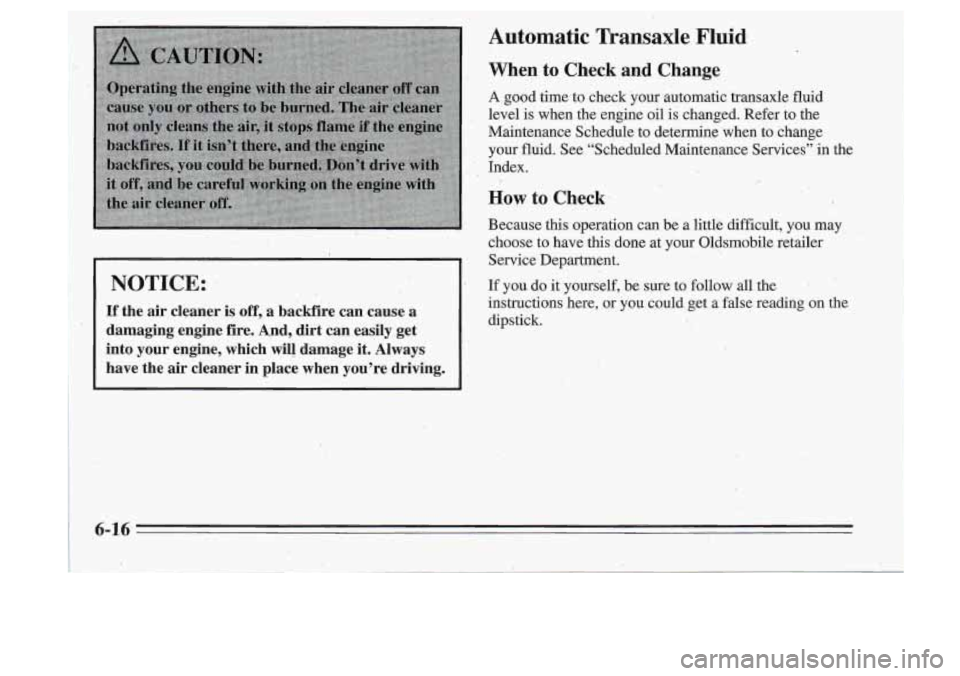
NOTICE:
If the air cleaner is off, a backfire can cause a
damaging engine fire. And, dirt can easily ,get
into your engine, which will damage it. Always
have the air cleaner in place when you’re driving.
Automatic Transaxle Fluid
When to Check and Change
A good time to check your automatic transaxle fluid
level is when the engine oil is changed. Refer to the
Maintenance Schedule to determine when to change
your fluid. See “Scheduled Maintenance Services’’ in the
Index.
How to Check
Because this operation can be a little difficult, you may
choose to have this done at your Oldsmobile retailer
Service Department.
If yon do it yourself, be sure to follow all the
instructions here,
or you could get a false reading on the
dipstick.
Page 227 of 340
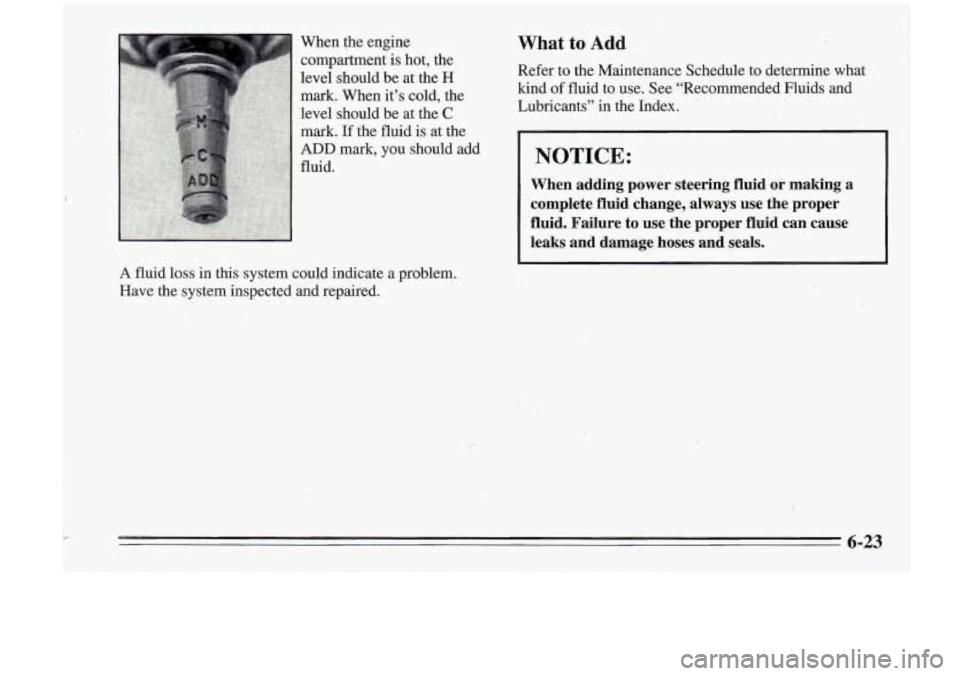
When the engine
compartment is hot, the
level should be at the
H
mark. When it’s cold, the
level should be at the
C
What to Add
Refer to the Maintenance Schedule to determine what
kind of fluid to use. See “Recommended Fluids and
Lubricants” in the Index.
mark.
If the fluid is at the I
NOTICE:
When adding power steering fluid or making a
complete fluid change, always use the proper
fluid. Failure to use the proper fluid can cause
leaks and damage hoses and seals.
A fluid loss in this system could indicate a problem.
Have the system inspected and repaired.
6-23
Page 246 of 340
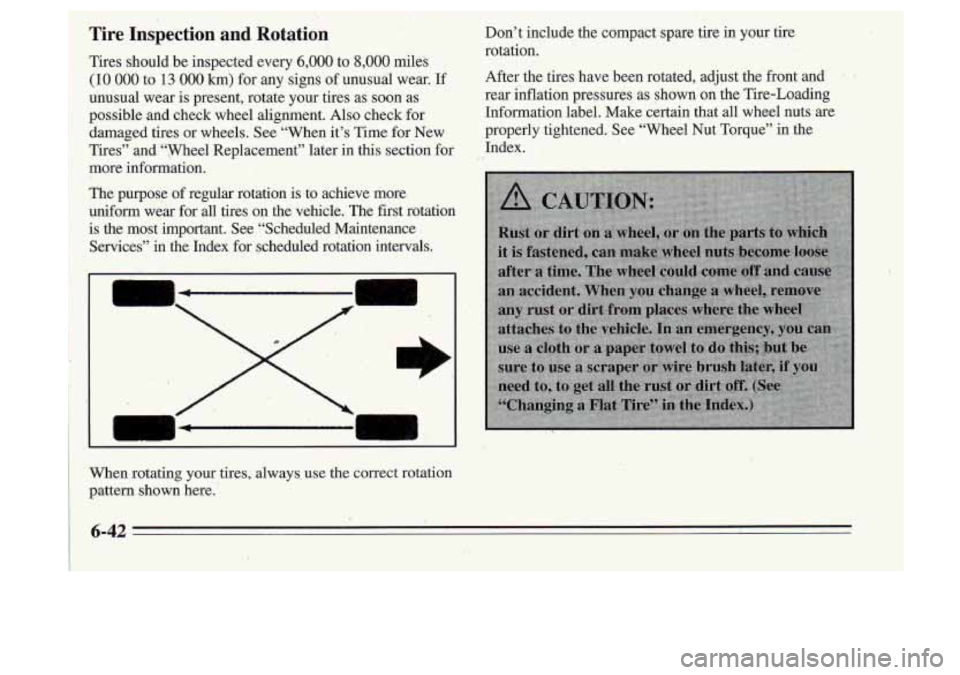
Tire Inspection and Rotqtion
Tires should be inspected every 6,000 to 8,000 miles
(IO 000 to 13 000 km) for any signs of unusual wear. If
unusual wear is present, rotate your tires as soon as
possible and check wheel alignment. Also check for
damaged tires or wheels. See “When it’s Time for New
Tires” and ‘‘Fheel Replacement” later
in this section for
more information.
The purpose
of regular rotation isto achieve more
uniform wear for
all tires on the vehicle. The first rotation
is the most important. See “Scheduled Maintenance
Services” in the Index for scheduled rotation intervals.
I 1 I I
Don’t include the compact spare tire in your
rotation.
After the tires have been rotated, adjust the
f
tire
ront and
’,
rear idlation pressures as shown. on the Tire-Loading
Information label. Make certain that
all wheeI nuts are,
properly tightened. See “Wheel Nut Torque” in the
Index.
When rotating
your tires, always, use the correct rotation
pattern sho.wn here.’
6-42
I
Page 260 of 340
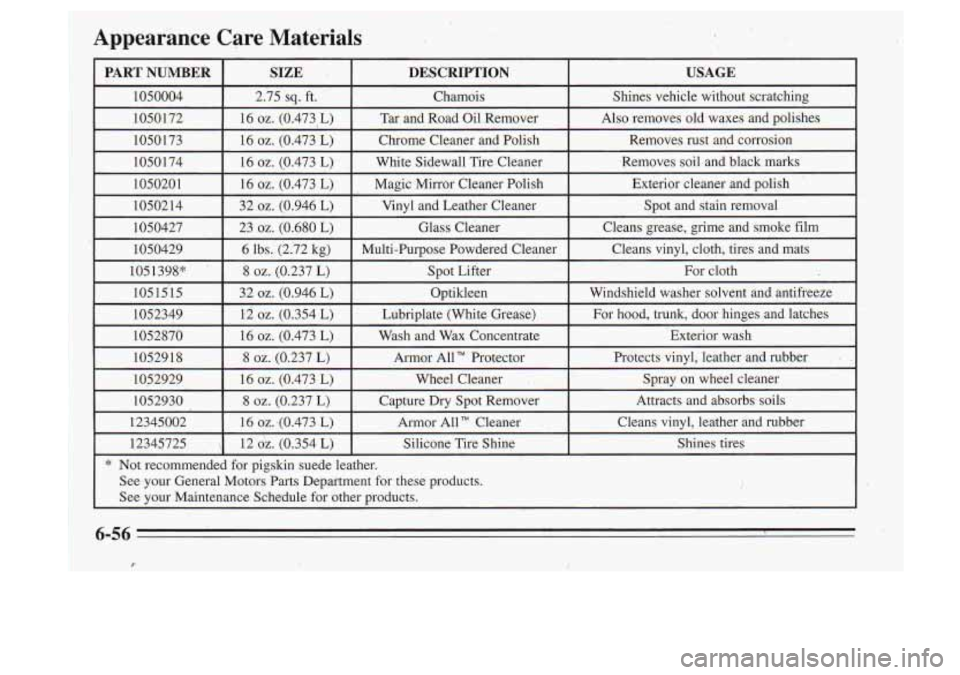
Appearance Care Materials
* Not recommended for pigskin suede leather.
I See your General Motors Parts Department for these products.
See your Maintenance Schedule for other products.
6-56 ,
I ’-- I
.. .
Page 271 of 340
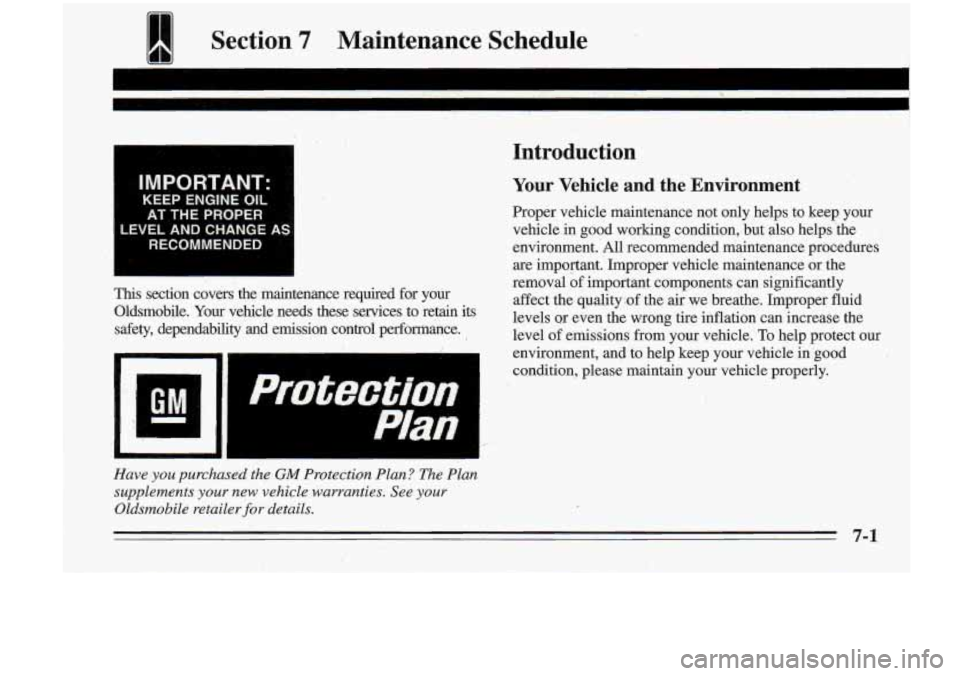
1 Section 7 Maintenance Schedule
I
IMPORTANT:
KEEP ENGINE OIL
AT THE PROPER
LEVEL AND CHANGE AS
RECOMMENDED
This section covers the $ naintenml ce required for yoiir
Oldsmobile. Your vehicle,needs these services to retain its
safety, dependability .and emission control performar ,
Introduction
Your Vehicle and the Environment
Proper vehicle maintenance not only helps to keep your
vehicle in good working condition, but also helps the
environment. All recommended maintenance procedures
are important. Improper vehicle maintenance or the
removal of important components can significantly
affect the quality 'of the air we breathe. Improper fluid
levels or even the wrong tire inflation can increase the
level of emissions from your vehicle.
TO help protect our
environment, and to help keep your vehicle ingood
condition, please maintain your vehicle properly.
Have you purchased the GM Protection -Plan? The Plan
supplements
your new vehicle warranties. See your
Oldsmobile retailer for details.
7-1
Page 273 of 340
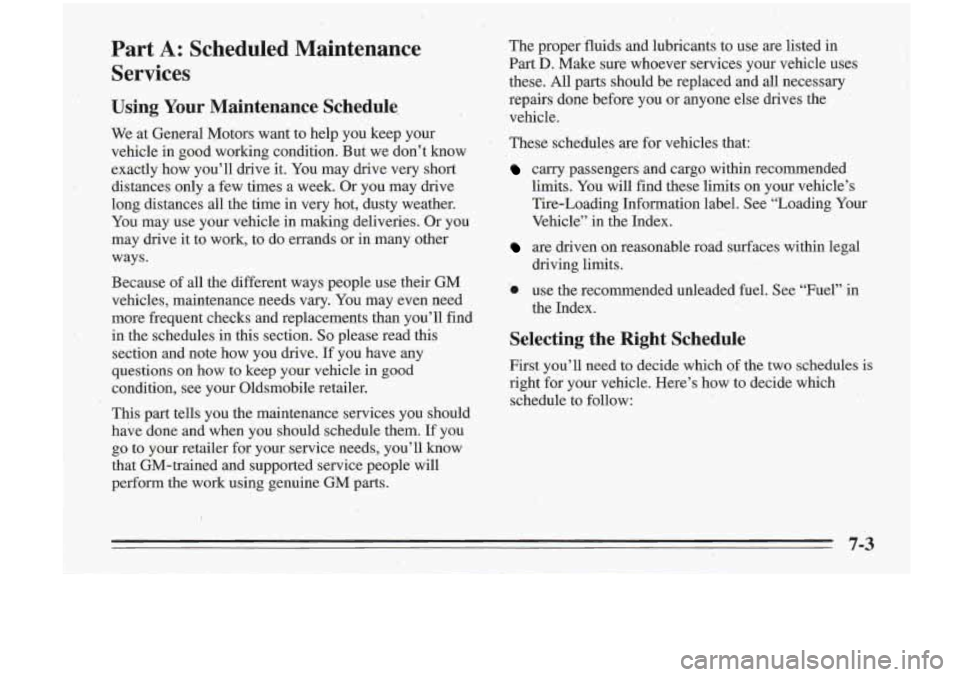
,Part A: Scheduled Maintenance
Services
Using Your Maintenance Schedule,
We at General Motors want to help you keep your
vehicle in good working condition. But we don? know
exactly how you’ll drive it. You may drive very short
distances only a few times a week. Or you may drive
long distances all the time in
very hot, dusty weather.
You may use your vehicle in making deliveries. Or you
may drive
it to work, to do errands or in many other
ways.
Because of all the different ways-people use their GM
vehicles, maintenance needs vary. You may even need
.more frequent checks and replacements than you’ll find
in the schedules in this section.
So please read this
section adnote how you drive.
If you have any
questions on how to keep your vehicle in
good
condition, see your Oldsmobile retailer.
This part tells you the maintenance services you should
have done and when you should schedule them.
If you
go to your retailer for your service needs, you’ll know
that GM-trained and supported service people will
perform the work using genuine GM parts.
IT I-
The proper fluids and lubricants to use are listed in
Part D. Make sure whoever services your vehicle uses
these. All parts should be replaced and all necessary
repairs done before you or anyone else drives the
vehicle.
These schedules are for vehicles that:
carry passengers and cargo within recommended
limits. You will find these limits on your ve.hicle’s
Tire-Loading Information label. See “Loading Your
Vehicle” in the Index.
are driven on reasonable road surfaces within legal
0 use the recommended unleaded fuel. See “Fuel” in
driving limits.
the Index.
Selecting the Right Schedule
First you’ll need to decide which of the two schedules is
right for your vehicle. Here’s how to decide which.
schedule to follow:
7-3
Page 274 of 340

,i
Maintenance Schedule
Schedule I Definition
Follow Maintenance Schedule I if any one of these is
true for your vehicle:
' Most tripsare less than 5 to 10 miles (8 to 16 km).
This 'is particularly important when outside
temperatures are below freezing.
0 'Most trips include extensive idling (such as frequent
driving in stop-and-go traffic).
Most trips are through dusty areas.
You frequently tow a trailer or use a carrier on top of
Schedule
I should also be followed if the vehicle is used
for delivery service, police, taxi, or other commercial
application. your vehicle.
I Schedule I Intervals
Every 3,000 Miles (5 000 b) or 3 Months,
'Whichever Occurs First
Every
6,000 Miles (10 000 km) or 6 months,
Whichever Occurs First
Chassis Lubrication
At-6,000 Miles (10 000 km) - Then Every
12,000 Miles (25 000 km)
Every 15,000 Miles (25 000 km).
Every 30,000 Miles (50 000 km),
Engine Oil and Filter Change
I
Tire Rotation
Air Cleaner Filter Inspection, if driving in dusty conditic
Air Cleaner Filter Replacement Spark Plug Replacement
Spark Plug Wire Inspection
Fuel Tank, Cap and Lines Inspection
Engine Accessory Drive Belt Inspection (or every 24 months, whichever occurs
first)
ms
Cooling System Service (or every
24 months, whichever
occurs first)
Every 50,000 Miles (83 000 km)
At 60,000 Miles (100 000 km) - Then Every.
15,600 Miles (25 000 km)
Autdmatic Transaxle Service (severe conditions only)
Camshaft Timing Belt Inspection (3.4L Code
X engine only)
7-4
!